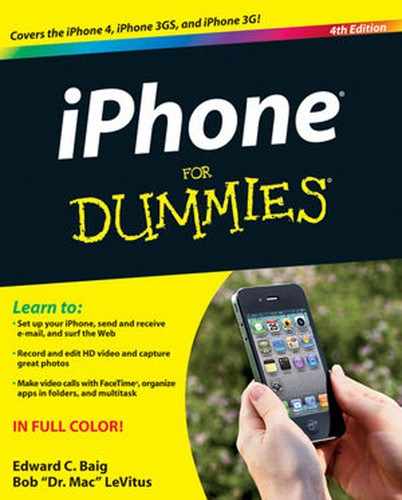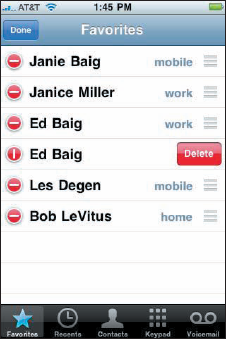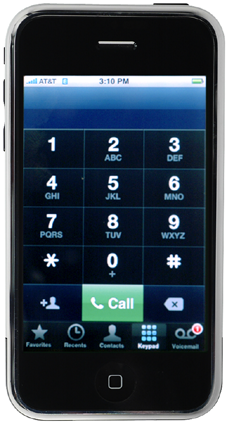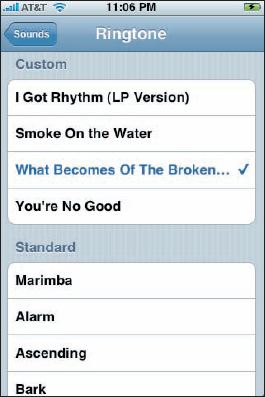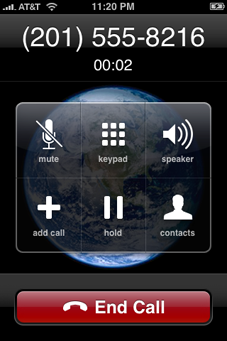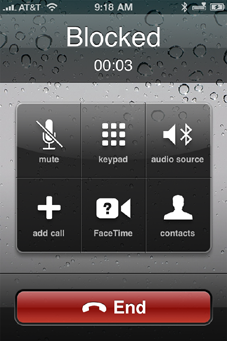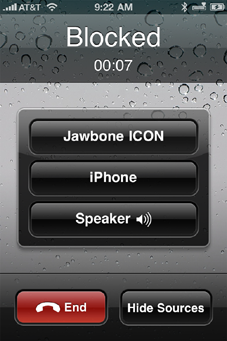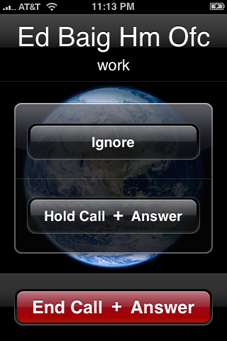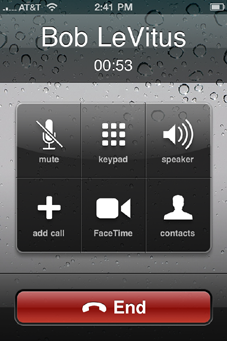Making a call
Visualizing visual voicemail
Recording a greeting
Calling hands-free
Receiving a call
Choosing ringtones
Setting up conference calls
Facing up to FaceTime
You may well have bought an iPhone for its spectacular photo viewer, marvelous widescreen iPod, and the best darn pocket-sized Internet browser you've ever come across. Not to mention its overall coolness.
For most of us, though, cool goes only so far. The iPhone's most critical mission is the one from which its name is derived — it is first and foremost a cell phone. And no matter how capable it is at all those other things, when push comes to shove, you had best be able to make and receive phone calls.
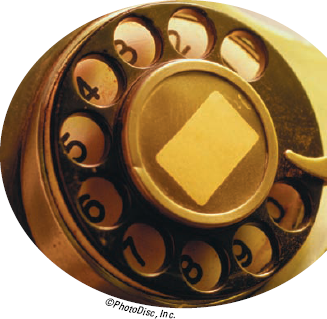
That puts a lot of responsibility in the hands of AT&T, the iPhone's exclusive wireless carrier in the United States. As with any cell phone, the strength of the wireless signal depends a great deal on your location and the robustness of the carrier's network.
As noted in Chapter 1, the cell-signal status icon at the upper-left corner of the screen can clue you in on what your phone-calling experience may be like. Simply put, more bars supposedly equate to a better experience. What you hope to avoid are those two dreaded words: No Service. Cell coverage aside, this chapter is devoted to all the nifty ways you can handle wireless calls on an iPhone.
And when we say nifty, we mean nifty. If you have an iPhone 4 and a good Wi-Fi connection and are gabbing with someone else who has an iPhone 4 and decent Wi-Fi, the two of you can see each other. That's right: video calling, through a remarkable feature called FaceTime. The promise of video calling has been around since LBJ occupied the White House. Despite various efforts to bring video calling or video chat to computers and certain other mobile handsets, video calling has never really gone Main Street.
We're betting that with FaceTime, Apple is going to change that. Don't take our word for it; give FaceTime a try. Sorry, but we're going to leave you hanging until the end of the chapter to figure out how to do that. (Trust us, giving FaceTime a whirl isn't hard.)
In the meantime, we present more conventional but no less important ways to make and receive calls on your iPhone. Somewhere, Alexander Graham Bell is beaming.
Start by tapping the Phone icon on the Home screen. You can then make calls by tapping any of the icons that show up at the bottom of the screen: Favorites, Recents, Contacts, Keypad, or Voicemail, in that order. The iPhone 3GS and the iPhone 4 have one more way of calling, by using the aptly named Voice Control feature to dial a name or phone number by voice. Let's take these options one by one.
If you read the chapter on syncing (Chapter 3), you know how to get the snail-mail addresses, e-mail addresses, and (most relevant for this chapter) phone numbers that reside on your PC or Mac into the iPhone. Assuming that you went through that drill already, all those addresses and phone numbers are hanging out in one place. Their not-so-secret hiding place is revealed when you tap the Contacts icon in the Phone app or the Contacts icon on one of the Home screen pages.
Here's how to make those contacts work to your benefit:
Flick your finger so the list of contacts on the screen scrolls rapidly up or down, loosely reminiscent of the spinning Lucky 7s (or other pictures) on a Las Vegas slot machine.
Think of the payout on a One-Armed Bandit with that kind of power.
Tip
Alternatively, you can move your fingers along the alphabet on the right edge of the Contacts list or tap one of the letters to jump to names that begin with that letter, easier said than done given how tiny those letters are.
You can find a list of potential matches also by starting to type the name of a contact in the search field. Or type the name of the place your contact works. You may have to flick to get the search field into view. Another way to find people is by using Spotlight (refer to Chapter 2).
When you're at or near the appropriate contact name, stop the scrolling by tapping the screen.
Tip
Note that when you tap to stop the scrolling, that tap doesn't select an item in the list. This may seem counterintuitive the first few times you try it, but we got used to it and now we really like it this way.
Tap the status bar of the tiny magnifying glass on the upper-right corner to automatically scroll to the top of the list and bring the search field into view. Doing so is useful if you're really popular (or influential) and have a whole bunch of names among your contacts.
Tap the name of the person you want to call.
As shown in Figure 4-1, you can see a bunch of fields with the individual's phone numbers, physical and e-mail addresses, and possibly even a mug shot. You may have to scroll down to see more contact info.
If the person has more than one phone number, the hardest decision you must make is choosing which number to call.
Tap the phone number, and the iPhone initiates the call.
If you lumped your contacts into Groups on your computer, reflecting, say, different departments in your company, friends from work, friends from school, and so on, you can tap the Groups button on the upper-left side of the screen labeled All Contacts to access these groups.
Tip
Your own iPhone phone number, lest you forget it, appears at the top of the Contacts list, provided you arrived in Contacts through the Phone app.
You can also initiate text messages and e-mails from within Contacts. Those topics are discussed in greater depth in Chapters 5 and 11, respectively.
Favorites is where you can keep a list of the people and numbers you dial most often. Consider Favorites the iPhone equivalent of speed-dialing. Merely tap the person's name in Favorites, and your iPhone calls the person.
Tip
You can set up as many favorites as you need for a person. So, for example, you may create separate Favorites listings for your spouse's office phone number and cell number.
Setting up Favorites is a breeze. When looking at one of your contacts, you may have noticed the Add to Favorites button. When you tap this button, all the phone numbers you have for that person pop up. Tap the number you want to make into a favorite and it turns up on the list.
If any of your chosen folks happen to fall out of favor, you can easily kick them off the Favorites roster. Here's how:
Tap the Edit button in the upper-left corner of the screen.
You'll notice that a red circle with a horizontal white line appears to the left of each name in the list.
Tap the circle next to the A-lister getting the heave-ho.
The horizontal white line is now vertical and a red Delete button appears to the right of the name, as shown in Figure 4-2.
The person (or one of his or her given phone numbers) is no longer afforded the privilege of being in your iPhone inner circle.
Tip
You can rearrange the order in which your favorites are displayed. Tap Edit, and then, to the right of the person you want to move, press your finger against the symbol that looks like three short horizontal lines stacked on top of one another. Drag that symbol to the place on the list where you want your favorite contact to appear. Tap Done when the listings are as you like them.
You can designate new favorites from the Favorites feature by tapping the + symbol at the upper-right corner of the screen. Doing so brings you back to Contacts. From there, select the appropriate person and number. A star appears next to any contact's number chosen as a favorite.
Tapping the Recents icon displays the iPhone call log. The Recents feature houses logs of all the, well, recent calls made or received, as well as calls you missed.
Here's a tricky concept: Tap All to show all the recent calls and Missed to show just those you missed. Under the All list, completed calls and missed calls that have been returned by tapping the red entry are shown in black, and missed calls that haven't been returned in this fashion are in red, along with a descriptor of the phone you were calling or received a call from (home, mobile, and so on).
By tapping the small blue circle with the right-pointing arrow next to an item in the list, you can find out the time calls were made or missed, as well as any known info about the caller from your Contacts information.
To return a call, just tap anywhere on the name.
Tip
If one of the calls you missed came from someone who isn't already in your Contacts, you can add him or her. Tap the right-pointing arrow, and then tap the Create New Contact button. If the person is among your Contacts but has a new number, tap the Add to Existing Contact button. When the list gets too long, tap Clear to clean it up.
Tap Share Contact to share a contact with a friend, family member, or colleague. You have the option to send that person an e-mail or MMS (text message). The contact info is already embedded in the message that you send.
From time to time, of course, you have to dial the number of a person or company who hasn't earned a spot in your Contacts. That's when you'll want to tap the Keypad icon to bring up the large keys of the virtual touchtone keypad you see in Figure 4-3. Just tap the appropriate keys and tap Call.
Tip
To add this number to your address book, tap the + silhouette key (that's a + and the silhouette of a person) on the keypad and tap either Create New Contact or Add to Existing Contact.
You can use the iPhone's keypad also to remotely check your voicemail at work or home.
Come to think of it, what a perfect segue into the next section. It's on one of our favorite iPhone features, visual voicemail.
How often have you had to listen to four or five (or more) voicemail messages before getting to the message you really want, or need, to hear? As shown in Figure 4-4, the iPhone's clever visual voicemail presents a list of your voicemail messages in the order in which calls were received. But you need not listen to those messages in order.
How do you even know you have voicemail? There are a couple ways:
A red circle showing the number of pending messages awaiting your attention appears above the Phone icon on the Home screen or above the Voicemail icon from within the Phone app.
You may also see a message on the iPhone display that says something like, New voicemail from Ed (or Bob).
Whatever draws you in, tap that Voicemail icon to display the list of voicemails. You see the caller's phone number, assuming this info is known through CallerID, and in some cases, his or her name. Or you see the word Unknown.
The beauty of all this, of course, is that you can ignore (or at least put off listening to) certain messages. We are not in the advice-giving business on what calls you can safely avoid; disregard messages from the IRS or your parole officer at your own risk, okay?
A blue dot next to a name or number signifies that you haven't heard the message yet.
To play back a voicemail, tap the name or number in question. Then tap the tiny play/pause button that shows up to the left. Tap once more to pause the message; tap again to resume. Tap the Speaker button if you want to hear the message through the iPhone's speakerphone.
Tip
Tap the blue arrow next to a caller's name or number to bring up any contact info on the person or to add the caller to your Contacts.
Tip
The tiny playhead along the scrubber bar (refer to Figure 4-4) shows you the length of the message and how much of the message you've heard. If you hate when callers ramble on forever, you can drag the playhead to rapidly advance through a message. Perhaps more importantly, if you miss something, you can replay that segment.
Returning a call is as simple as tapping the green Call Back button. If the caller's number is unknown, the Call Back button appears dimmed. And you can delete a voicemail by pressing Delete.
If you have no phone service, you'll see a message that says Visual Voicemail is currently unavailable.
Tip
You can listen to your iPhone voicemail from another phone. Just dial your iPhone number and, while the greeting plays, enter your voicemail password. You can set up such a password from the Home screen by tapping Settings, and then tapping Phone, Change Voicemail Password. You'll be asked to enter your current voicemail password, if you have one. If one doesn't exist yet, tap Done. If it does exist, enter it and then tap Done. You'll then be asked to type the new password and tap Done, twice.
Note
You have two choices when it comes to the voicemail greeting your callers will hear. You can accept a generic greeting with your phone number by default. Or you can create a custom greeting in your own voice as follows:
In the voicemail app, tap the Greeting button.
Tap Custom.
Tap Record and start dictating a clever, deserving-of-being-on-the-iPhone voicemail greeting.
When you have finished recording, tap Stop.
Review the greeting by pressing Play.
If the greeting is worthy, tap Save. If not, tap Cancel and start over at Step 1.
If you have a 3GS phone or an iPhone 4, you can make a call hands-free, just by opening your mouth.
To summon Voice Control (refer to Chapter 2), press and hold the Home button or press and hold the center button on the wired headset with the remote and microphone supplied with the iPhone.
Wait for the tone and speak clearly, especially if you're in a noisy environment. You can dial by number, as in "Dial 202-555-1212." You can dial a name, as in "Call Bob LeVitus" or "Dial Ed Baig." Or you can be a tad more specific as in "Dial Bob LeVitus mobile" or "Call Ed Baig home." Before actually dialing the phone, an automated female voice repeats what she thinks she heard.
If the person you're calling has multiple phone numbers and you fail to specify which one, the female voice will prompt you, "Ed Baig, home, mobile, or work?" Tell her which one it is, or say "Cancel" if you decide not to call.
Tip
When the Voice Control screen appears, let go of the Home button before speaking a command. Otherwise, your thumb may cover the microphone, making it more difficult for the iPhone to understand your intent.
Tip
Voice Control need not be in Americanized English. From the Home screen, tap Settings, General, International, Voice Control. Then choose one of several language options in the list. Choices include Australian English and English as spoken in the U.K.
It's wonderful to have numerous options for making a call. But what are your choices when somebody calls you? The answer depends on whether you are willing to take the call or not.
To accept a call, you have three options:
Tap Answer and greet the caller in whatever language makes sense.
If the phone is locked, drag the slider to the right.
If you are donning the stereo earbuds that come with the iPhone, tap the microphone button. Microphone adapters for standard headsets may also work.
Tip
Actually, you have a fourth option if you wear a wireless Bluetooth headset or use a car speakerphone. Click the Answer button on your headset or speakerphone (refer to the manual if the process isn't intuitive). For more on Bluetooth, read Chapter 13.
Note
If you're listening to music in your iPhone's iPod when a call comes in, the song stops playing and you have to decide whether to take the call. If you do take the call, the music resumes from where you left off after the conversation ends.
We're going to assume that you're not a cold-hearted person out to break a caller's heart. Rather, we assume that you are a busy person who will call back at a more convenient time.
Keeping that positive spin in mind, here are three ways to reject a call on the spot and send the call to voicemail:
Tap Decline. Couldn't be easier than that.
Press the sleep/wake button twice in rapid succession. (The button is on the top of the device.)
Using the supplied headset, press and hold the microphone button for a couple of seconds, and then let go. Two beeps let you know that the call was indeed rejected.
Tip
Sometimes you're perfectly willing to take a call but you need to silence the ringer or turn off the vibration, lest the people sitting near you in the movie theater or corporate boardroom cast an evil eye your way. To do so, press the sleep/wake button a single time, or press one of the volume buttons. You'll still have the opportunity to answer.
At the time this book was written, Apple included 25 ringtones in the iPhone, ranging from the sound of crickets to an old car horn. Read the "iTunes and ringtones" sidebar to figure out how to create your own custom ringtones.
To choose a ringtone, follow these steps:
From the Home screen, tap Settings.
Tap Sounds.
Tap Ringtone to access the list of available ringtones.
Tap any of the ringtones to hear what it will sound like.
A check mark appears next to the ringtone you've just listened to, as shown in Figure 4-5. If need be, adjust the volume slider in Sounds.
If you're not pleased, try another.
If you're satisfied, you need do nothing more. Unbeknownst to you, you have just selected that ringtone.
Tip
You can easily assign specific ringtones to individual callers. From Contacts, choose the person to whom you want to designate a particular ringtone. Then tap Edit, and then tap Assign Ringtone to display the aforementioned list of ringtones. Select the one that seems most appropriate (a barking dog, say, for your father-in-law).
To change or delete the ringtone for a specific person, go back into Contacts, and then tap Edit. Either tap the right arrow to choose a new ringtone for that person or tap the red circle and Delete to remove the custom ringtone altogether.
You can do lots of things while talking on an iPhone, such as consulting your Calendar, taking notes, or checking the weather. Press the Home button to get to these other apps.
Tip
If you're using Wi-Fi or 3G, you can also surf the Web (through Safari) while talking on the phone. But you can't surf while you talk if your only outlet to cyberspace is the EDGE network.
Here are other things you can do while on a call:
Mute a call: From the main call screen (shown in Figure 4-6), tap Mute. Now you need not mutter under your breath when the caller ticks you off. Tap Mute again to unmute the sound.
Tap Contacts to display the Contacts list. This is useful if you want to look up a friend's number while you're talking to another pal.
Place a call on hold: This option depends on the phone you're using. If you're on an iPhone 4, touch and hold the aforementioned Mute button. On older devices, just tap Hold. Tap Hold again to take the person off hold. You might put a caller on hold to answer another incoming call or to make a second call yourself. The next section shows you how to deal with more than one call at a time.
Tap Keypad to bring back the keypad: This feature is useful if you have to type touchtones to access another voicemail system or respond to an automated menu system. Heaven forbid you actually get a live person when calling an insurance company or airline. But we digress... .
Use the speakerphone: Tap Speaker to listen to a call through the iPhone's internal speakers without having to hold the device up to your mouth. If you've paired the iPhone with a Bluetooth device, the control is labeled Audio Source instead, as shown in Figure 4-7. Tap Audio Source and then tap Speaker (if you want the speakerphone), iPhone (if you want to hold up the phone to your ear), or the name of the Bluetooth device. A tiny speaker icon will appear next to your selection, as shown in Figure 4-8.
You can field a new call when you're already talking to somebody. Or ignore it (by tapping Ignore).
To take the new call while keeping the first caller on hold, tap the Hold Call + Answer button that appears, as shown in Figure 4-9. You can then toggle between calls (placing one or the other on hold) by tapping either the Swap button or the first call at the top of the screen.
If this is too much for you and that second caller is really important, tap End Call + Answer to ditch caller number one.
Now suppose caller number one and caller number two know each other. Or you'd like to play matchmaker so they get to know each other. Tap Merge Calls so all three of you can chitchat. At first, the phone number of each caller will scroll at the top of your screen like a rolling ticker. A few seconds later, the ticker is replaced by the word Conference with a circled right-pointing arrow to its immediate right.
Now let's assume you have to talk to your entire sales team at once. It may be time to initiate a full-blown conference call, which effectively takes this merge-call idea to its extreme. You can merge up to five calls at a time. In fact, creating such a conference call on the iPhone may be simpler than getting the same five people in a physical room at the same time.
Here's how you do it. Start by making a call and then placing the caller on hold as noted in the preceding "Juggling calls" section. Tap Add Call to make another call, and then tap Merge Calls to bring everyone together. Repeat this exercise to add the other calls.
Other conference call tidbits:
iPhone is actually a two-line phone, and one of the available lines can be involved in a conference call.
If you want to drop a call from a conference, tap Conference, and then tap the red circle with the little picture of the phone in it that appears next to the call. Tap End Call to make that caller go bye-bye.
You can speak privately with one of the callers in a conference. Tap Conference, and then tap Private next to the caller you want to go hush-hush with. Tap Merge Calls to bring the caller back into the conference so everyone can hear him or her.
You can add a new incoming caller to an existing conference call by tapping Hold Call + Answer followed by Merge Calls.
FaceTime video reminds us of a favorite line from The Who's rock opera Tommy: "See me, feel me, touch me." The "see me" (and for that matter, "see you") part arrives with FaceTime. We think a lot of people will want to see you: an old college roommate living halfway around the world; grandparents living miles away (okay, they really want to see your newborn); or an old flame in a distant location.
Fortunately, using FaceTime is as easy as making a regular call on the iPhone. Plus, FaceTime comes with at least two major benefits, besides the video:
But FaceTime also has a couple of major caveats:
Both you and the party you're talking to must have an iPhone 4. FaceTime doesn't work with older models of the iPhone or any other devices as of this writing. Apple is pushing to make FaceTime a video standard that the entire tech industry can embrace, allowing you to someday (and maybe even by the time you read this) make FaceTime calls from iPhone 4 to other handsets and computers, perhaps machines compatible with the iChat video feature on Macs.
Both you and the caller at the other end have to access Wi-Fi. The quality of the experience depends on a solid connection.
If you meet the requirements, here's how to make FaceTime happen:
The first time you make a FaceTime call, dial the person's regular iPhone number as usual, using any of the methods we describe in this chapter.
Once a regular call is established and you've broached the subject of going video, you can tap the FaceTime button shown in Figure 4-10.
A few seconds later, the other person gets the option to Decline or Accept the FaceTime invitation by tapping the red button or the green button, respectively, as shown in Figure 4-11. If the answer is Accept, you'll need to wait a few seconds before you can see the other person.
When someone requests FaceTime with you, you'll appreciate being able to politely decline a FaceTime call. Cool as it can be to see and be seen, ask yourself if you really want to be seen, say, when you just got out of bed.
Although your initial FaceTime call likely involves AT&T, your next call doesn't have to because the connection is via Wi-Fi once FaceTime commences. Search for any FaceTime calls you previously made by tapping an entry for that call in Recents. The iPhone knows to take the call straight to video, though of course the person you're talking to has to accept the invitation each time.
You can do FaceTime also by tapping a pal's listings in Contacts.
So what is a FaceTime call like? In our experience, first-time reactions were gleeful. Not only are you seeing the other person, but the quality of the video is also typically good. You also see your own mug in a small picture-in-picture (PiP) window (as shown in Figure 4-12), which you can drag to a corner of the screen. The PiP image represents what the other person sees, so it's a good way of knowing, short of the other person telling you, if your face has dropped out of the frame.
Tip
You can use FaceTime in portrait or landscape mode. You might find it easier to bring another person into a scene in landscape mode.
Tip
Apple says the front camera has been fine-tuned for FaceTime usage, which in photography-speak means the camera has the proper field of view and focal length. But at times, you'll want to employ the iPhone's main camera on the rear to best show off your surroundings and give the caller an idea of where you are.
To toggle between the front and main cameras, tap the icon at the bottom-right corner of the screen (refer to Figure 4-12).
If you want to mute a FaceTime video call, tap the microphone icon with the slash running through it. The caller can continue to see you but not hear you.
Tip
Although many FaceTime calls commence with a regular AT&T call, you can't go from FaceTime to an audio-only call without hanging up and redialing. Similarly, if you drop a FaceTime call because of a Wi-Fi hiccup or some other problem, you'll have to redial via FaceTime or AT&T, depending on whether you want the call to be video or only audio.
Tip
To block all FaceTime calls, tap Settings from the Home screen, tap Phone, and make sure FaceTime is off. If you can't find the FaceTime button or wonder why you're not getting FaceTime calls, go back into Settings and make sure this option is turned on.
If you want to momentarily check out another iPhone app while on a FaceTime call, press the Home button and then tap the icon for the app you have in mind. At this point, you can still talk over FaceTime, but you'll no longer see the person. Tap the green bar at the top of the screen to bring the person back in front of you.
And there you have it. That's FaceTime, arguably the coolest new feature in the iPhone.
You can do even more things with iPhone the phone, as you find out in Chapter 13. Meanwhile, we recommend that you read the next chapter to figure out how to become a whiz at text messaging.
